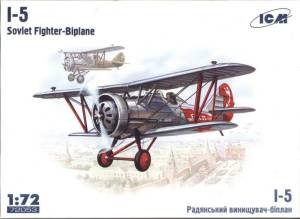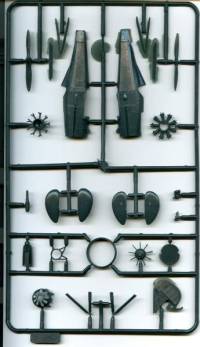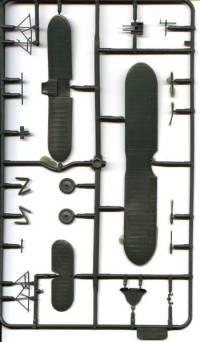ICM 1/72nd Polikarpov I-5 (late)
|
 |
History
In light of trying to get this review "out the door", I'm
foregoing a history section. Just let it be known that the I-5 was the
predecessor to the very successful I-15 series of aircraft.
The Kit
 There
are two versions of this kit released. The first ICM Polikarpov I-5 (which
I don't have yet) is known as the "early version" and differs
from the later version primarily with the forward fuselage, "cowl"
and engine. The I-5 that I'm reviewing here (the "later" type)
saw more widespread use and had more examples built. The ICM kit comes
with 41 green, injected molded pieces and a sprue of 6 clear pieces (which
includes an alternate windscreen). This "late" kit does come
with spats for the wheels, but the versions that are catered for on the
decal sheet don't use the spats. Another option in the kit is the prop
- there are two types dependent on which scheme you're building. The decal
schemes are for the widely known, very colorful machine of Moscow District
Air Defense Chief I.U. Pavlov, and an indiscriminate machine that flew
in 1941 (which is green uppers with blue undersides). Decals are sharp
and in register. There
are two versions of this kit released. The first ICM Polikarpov I-5 (which
I don't have yet) is known as the "early version" and differs
from the later version primarily with the forward fuselage, "cowl"
and engine. The I-5 that I'm reviewing here (the "later" type)
saw more widespread use and had more examples built. The ICM kit comes
with 41 green, injected molded pieces and a sprue of 6 clear pieces (which
includes an alternate windscreen). This "late" kit does come
with spats for the wheels, but the versions that are catered for on the
decal sheet don't use the spats. Another option in the kit is the prop
- there are two types dependent on which scheme you're building. The decal
schemes are for the widely known, very colorful machine of Moscow District
Air Defense Chief I.U. Pavlov, and an indiscriminate machine that flew
in 1941 (which is green uppers with blue undersides). Decals are sharp
and in register.
This is an exceptional kit. While there is some flash present it's not
enough to distract from how well molded this kit is. All of the detail
parts are very well molded and ICM has done a lot of work on this kit
to ensure a first rate model. Knowing how the ICM I-16 has some sink marks
present on the main pieces, I was initially leary to see the same problem
in the I-5. Not so. There are no sink marks are anything else that mars
the perfect exterior to this kit. In addition the cockpit out of the box
is more than sufficient for the very small opening - the only thing missing
are seat belts.
 Construction
does start with the interior and the cockpit pieces. Take your time with
clean-up so you don't break the fragile parts. Unfortunately the instructions
don't really show how some of the pieces fit into the interior. The problem
areas I can see are where the instrument panel sits, as well as the upper
guns. ICM has engineered the seat in a most unique way. In order to ensure
that corrugations are present on the sides of the seat as well as the
back, ICM molded it in such a way that the plastic sides are folded onto
the back, creating the bucket seat in the process. Not only does this
ensure the corrugations appear even and uniform, but it also makes for
a stronger - and easier to assemble - piece. Construction
does start with the interior and the cockpit pieces. Take your time with
clean-up so you don't break the fragile parts. Unfortunately the instructions
don't really show how some of the pieces fit into the interior. The problem
areas I can see are where the instrument panel sits, as well as the upper
guns. ICM has engineered the seat in a most unique way. In order to ensure
that corrugations are present on the sides of the seat as well as the
back, ICM molded it in such a way that the plastic sides are folded onto
the back, creating the bucket seat in the process. Not only does this
ensure the corrugations appear even and uniform, but it also makes for
a stronger - and easier to assemble - piece.
The cockpit "floor" (actually just a couple of rails leading
to an area under the rudder bar) is assembled onto the top of the lower
wing. With care taken you should be able to fit it all together later
without damaging the floor assembly.
The engine is another piece of awesome engineering. There exists a firewall
that is installed inside the fuselage. To that is added an engine support
structure, followed by the engine. This area could be super-detailed easily
if the hatches and what it looked like on the inside could be figured
out.
Once the fuselage is assembled, trapping everything, then construction
moves onto adding the tail pieces (where the tail skid is molded in-situ
with the rudder) followed by the engine, engine cover and cowl. Personally
I would leave these off until last to avoid overspray on the excellent
engine.
 Now
construction moves to the final phase. First is added the lower wing,
and I taped the fuselage halves together and dry-fit the lower wing to
them. This is going to be a perfect fit as my example is very tight in
this area, resulting in no seams. Superb! You then finish with struts,
the upper wing and landing gear. There are a few parts not supplied by
ICM but called out for in the instructions, such as the pilot's step.
These are not problematic to scratch and ICM is to be lauded for not trying
to mold these very small and delicate parts, which usually means they
have to be scratched anyway. Now
construction moves to the final phase. First is added the lower wing,
and I taped the fuselage halves together and dry-fit the lower wing to
them. This is going to be a perfect fit as my example is very tight in
this area, resulting in no seams. Superb! You then finish with struts,
the upper wing and landing gear. There are a few parts not supplied by
ICM but called out for in the instructions, such as the pilot's step.
These are not problematic to scratch and ICM is to be lauded for not trying
to mold these very small and delicate parts, which usually means they
have to be scratched anyway.
Conclusion
This is an awesome kit. I'm tempted to say it's the best biplane model
I've ever come across, but the extra work with the flash stays my hand.
However, don't get me wrong. I would much rather deal with flash than
try to accurize an already inaccurate kit or deal with fit problems. A
little bit of flash is nothing to complain about at all. If you enjoy
between the wars aircraft ('tweeners) or especially VVS aircraft, this
kit comes highly recommended.
|
|
